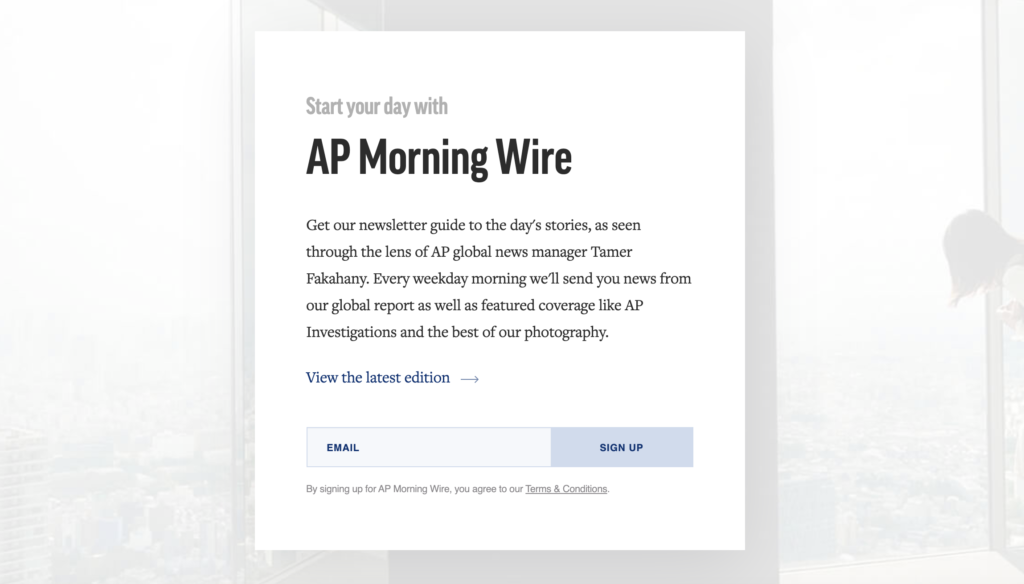
Create a newsletter worth reading: Tips from the experts
Tatyana Monnay is the RJI Student Innovation Fellow at the Associated Press. This summer our student fellows will be sharing dispatches from their fellowships in newsrooms across the country for Innovation in Focus.
Newsletters can be a powerful product to add to your newsroom to inform your community and engage them in topics they care about. At The Associated Press, I am helping them explore new options for newsletters and digital engagement. Eric Lubbers, a self-proclaimed newsletter wrangler at The Colorado Sun says newsletters can take “the passionate people who are writing about news and tell you why you should care.”
Here are some tips from Lubbers and other experts to help you launch a successful and useful newsletter
Decide what you want your newsletter to be
Will your newsletter be the product or something that connects readers to other products? The Local News Lab run by the Democracy Fund recommends figuring this out early on. Not only will it help you better form and create your newsletter but it’ll save you time in the long run. Lubbers recommends establishing the voice of the newsletter in the initial process. This will help shape decisions such as layout, design and what topics the newsletter covers.
Be realistic
You don’t want to waste time, money and energy pushing out a product that can’t meet its own goals. Tim Grieve of Protocol made a list of essential questions to answer before starting a newsletter.
After you figure out what you want your newsletter to do, the next step is scanning your resources. Ideas are great, but it’s necessary to stick to what is feasible.
Questions to present to your newsletter team:
- How much time per week can you put into production?
- How much money do you need for production, development and design?
- Who in your newsroom can work on this project?
- Who will write the newsletter?
Don’t be afraid to start small, you can always work yourself up to a bigger operation through grant funding, partnerships and sponsorships.
Find a platform that works with your newsroom and meets your needs
Substack and Mailchimp are reliable newsletter platforms that offer free memberships. Find a platform that can integrate well with the back end of your publishing site and is easy for you to use with your skillsets.
“[Substack] is just clean and simple, easy to use and that’s what’s important to me,” said Cari Wade Gervin, who publishes The Dog and Pony Show newsletter. “So far, it’s been a positive experience.”
If you’re finding that you need help with fixing code and making changes to the back end of the newsletter, don’t be afraid to reach out to other newsrooms that may have been through the same problems. They might have a solution ready to share.
Build a connection by engaging with your readers
Local newsrooms can utilize widespread breaking news events that affect their entire community, like COVID-19, to engage new readers while informing everyone at the same time.
Ask for feedback
Don’t be afraid to ask your audience what they think of the newsletter. Readers want to talk to tell you what they like, love or can’t stand about your product. Listening and adapting to feedback will improve your work and connection with your readers. The Google News Initiative Audience Lab recommends embedding a survey in your newsletter, giving readers an easy avenue for regular, direct communication.
Shameless self-promo
Once you’ve launched your newsletter, it’s time to promote it! Shout from the digital rooftops to let everyone know that your newsletter is open for subscribers. Reach out to organizations, Faceboook groups, clubs and local businesses who might be interested in it. Promotion should vary from targeted social media posts across platforms, direct communication and even an ad-hoc referral program with your most dedicated readers.
“If you are particularly proud of a part of the newsletter or quote, don’t be afraid to screenshot it and share it on your social as part of a preview.” said Lubbers, “Rather than broadly trying to describe what your newsletter is, let people see it,”
Measure your success and inevitable failures
While you figure out the ropes of your newsletter and adapt to your readers’ feedback, measuring your changes with concrete metrics can help you make data-informed decisions. This could mean keeping track of how many people open your newsletter, your active subscriber list size and site referrals from the newsletter.

Comments